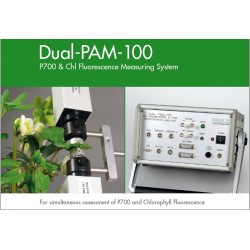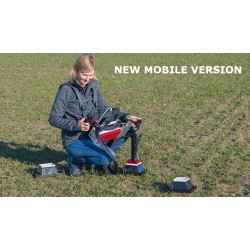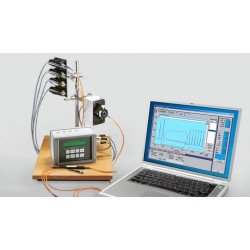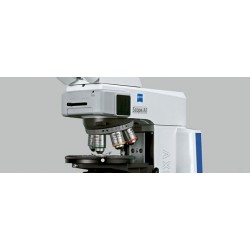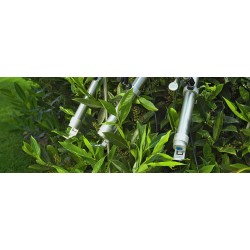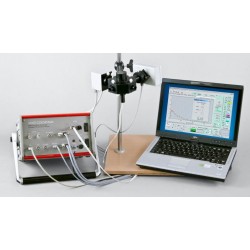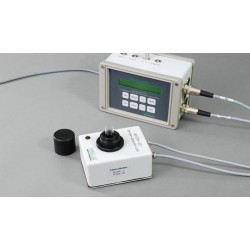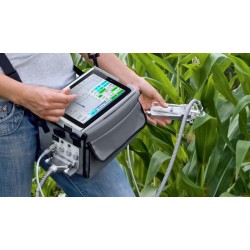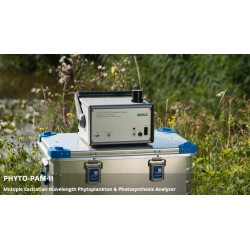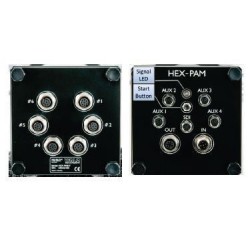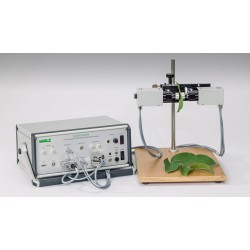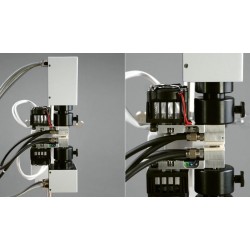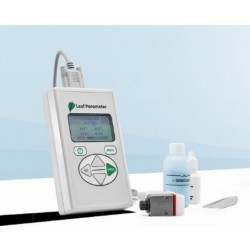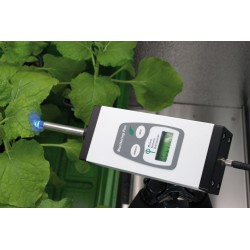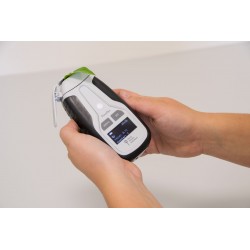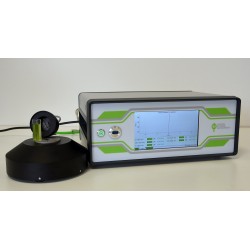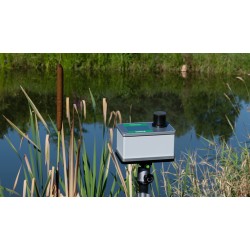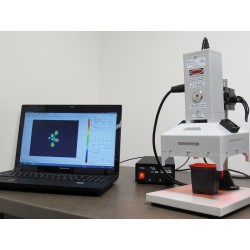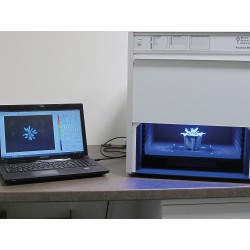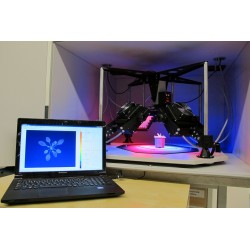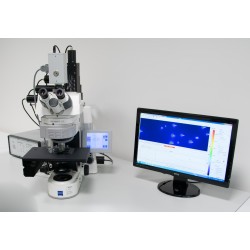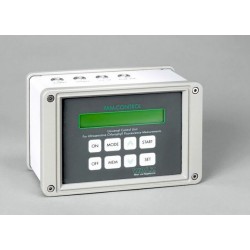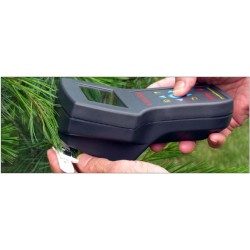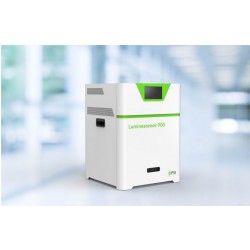No products
Prices are tax excluded
Product successfully added to your shopping cart
There are 0 items in your cart. There is 1 item in your cart.
DIVING-PAM-II Underwater Fluorometer with Miniature Spectrometer
DIVING-PAM-II
New
◆ System package with underwater spectrometer
◆ Operating range up to 50 m diving depth
◆ Internal PAR sensor
◆ Red or blue plus far-red light
The DIVING-PAM-II builds on the success of its predecessor, the DIVING-PAM, a reliable and robust chlorophyll fluorometer widely used for studying photosynthesis in aquatic environments. It has proven its value in research with over 500 scientific publications.
The DIVING-PAM-II incorporates advanced LED technology, improved optics, and modern electronics for enhanced data acquisition and instrument control, ensuring even greater precision and performance for underwater photosynthesis studies.
- Consulta este producto
- Remove this product from my favorite's list.
- Add this product to my list of favorites.
The DIVING-PAM-II fluorometer permits examinations of photosynthesis down to 50 m water depth. All functions of the instrument can be controlled by 10 infrared reflection switches situated inside a transparent, cylinder-shaped housing. A new feature is the energy-saving B/W screen which displays instrument status and measured data. The transflective screen is readable even under sunlight. For long-term assessment of photosynthesis, the instrument can also be operated by a computer via a special underwater cable.
The innovative Miniature Spectrometer MINI-SPEC, being part of the basic DIVING-PAM-II system, adds a new level of information to studies of photosynthesis. The MINI-SPEC measures spectra of PAR, which are known to vary significantly with water depth. The device also permits spectral analyses of reflectance and fluorescence emission of a sample. Also new is an internal PAR sensor which continuously records the intensity of the internal light source of the DIVING-PAM-II.
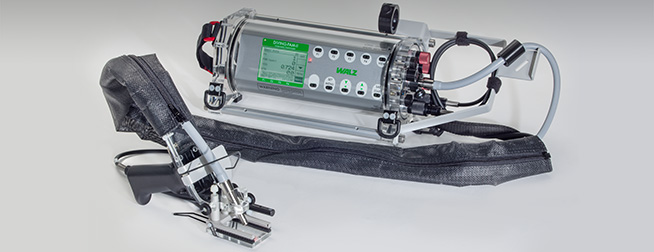
* DIVING-PAM-II and Universal Sample Holder DIVING-II-USH
- Miniature spectrometer for PAR measurement, spectral information on PAR and reflectance
- Wireless LAN for convenient data download at experimental site
- Graphical and alphanumerical display by low-power consuming transflective B/W screen
- High power LED for actinic light and saturation pulses. Far red LED for PS I excitation.
- Advanced pressure and temperature sensor
- High capacity battery for more than 1,300 PS II yield measurements. Flash memory for more than 27,000 saturation pulse analyses
- Continuous monitoring of internal light intensity by built-in PAR sensor
- Automatic calculation of all relevant parameters of saturation pulse analysis
- Accessories included in the basic system:
1.5 m flexible fiber optics, miniature spectrometer, distance clip, dark leaf clips, surface holder, PC Interface Box, battery charger, USB cable, 5 m underwater cable, WinControl-3 software packed in a rugged outdoor transport case
Optoelectronic Unit DIVING-PAM-II/B (BLUE Version)
Measuring light:Blue (470 nm) LED, standard modulation frequencies 5 to 25 Hz adjustable in increments of 5 Hz and 100 Hz, measuring light PAR at standard settings = 0.05 μmol m-2 s-1. Fluorescence at wavelengths greater than 630 nm is measured
Actinic light: Same blue LED as for measuring light, maximum actinic PAR = 3000 μmol m-2 s-1, maximum PAR of saturation pulses = 6000 μmol m-2 s-1 adjustable at increments of 500 μmol m-2 s-1
Optoelectronic Unit DIVING-PAM-II/R (RED Version)
Measuring light: Red (655 nm) LED, modulation frequencies and PAR as described for DIVING-PAM-II/B. Fluorescence at wavelengths greater than 700 nm is measured
Actinic light: Same red LED as for measuring light, maximum PAR of actinic light and saturation pulses as described for DIVING-PAM-II/B
Optoelectronic Unit DIVING-PAM-II/B & DIVING-PAM-II/R
Fluorescence detection: PIN photodiode protected by long-pass and a short-pass filters, 12 bit signal resolution
Pressure and temperature: Piezo-resistive pressure sensor and temperature sensor. Pressure is converted in meters of diving depth, range 0 to -50 m, displayed at 0.1 m intervals. Temperature, range -10 °C to +60 °C, displayed at 0.1 °C intervals. Sensor module with gel protection and antimagnetic stainless steel cap
Data storage: Flash memory, 8 MB, providing memory for more than 27,000 saturation pulse analyses
Display: Backlit 160 x 104 dots (78 x 61 mm) transflective B/W screen
Control elements: 10 infrared reflection switches, pushbutton for saturation pulses, pushbutton to switch device on/off and to lock/unlock reflection switches
WLAN: Wireless LAN Interface, IEEE 802.11 b/g/n (2.4 GHz), Access Point Mode
Design: Plexiglas tube with Plexiglas end plates, one with waterproof fiberoptics port
Mountings: 2 anodized aluminum rods (diameter 15 mm) mounted parallel to the fluorometer body. Anodized aluminum holder for fiber optics. Connections for carrying belt and miniature spectrometer MINI-SPEC
Ports: AUX1 and AUX2, 4-pole, for miniature spectrometer MINI-SPEC; for laboratory use via special adapter: Fiber-Optic Oxygen Meter FireStingO2 or Leaf Clip Holder 2035-B. OUT1 and OUT2, 6-pole, input for trigger signal from Universal Sample Holder DIVING-II-USH; for laboratory use via special adapter: External LED Light Source 2054-L. INPUT, 6-pole, for RS-485 communication and charging of internal battery
Battery: Lead acid battery 8.0 V / 3.5 Ah (28 Wh) providing power for more than 1300 yield measurements
Maximum diving depth: 50 m
Operating temperature: -5 to +45 °C
Dimensions: Diameter 19 cm, length 39 cm
Weight: 3.9 kg
Miniature Spectrometer MINI-SPEC
Design: POM tube, at one side, port for light detection, port for fluorescence excitation by blue (452 nm max) or green (525 nm max) LEDs, and port for white light from a tungsten lamp for reflection measurements; at the opposite side, 4-pole underwater socket
Spectrometer module: Hamamatsu micro-spectrometer, spectral range: 400 to 800 nm, spectral resolution: between 8 and 10 nm. Maximum PAR: 4000 µmol m-2s-1 for illumination having spectral characteristics similar to sunlight
Dimensions: 3.25 cm diameter, 17.5 cm length max
Weight: 135 g
MINI-SPEC Small Parts
Flat Entrance Optics SPEC/P: Design: Hard-anodized aluminum rod of 10 mm diameter and 50 mm length, at one end with lateral light entrance through a 5 mm diameter diffusor and the opposite end inserted in a mounting plate (diameter 33 mm, height 5 mm). Aluminum rod with internal light guide
Fluorescence and Reflection Optics SPEC/R: Design: Spectrometer cap consisting of POM: maximum diameter 35 mm, height 13 mm, weight 16 g. With central 5 mm x 16 mm groove accommodating Perspex light guides for blue and green for fluorescence excitation, and for white light for reflection measurements. With 3 mm diameter central drilled hole as light channel to the detector window of the spectrometer. Including sample cap to fix sample (maximum diameter 40 mm, height 10 mm, weight 8 g). Spectrometer and sample caps padded with foam rubber, both parts have magnets build-in to attract each other and, thus, hold the sample
PAR Calibration Block 000160101439: Design: POM block with drill hole for entrance optics of the Miniature Spectrometer. Oriented at an angle of 60° and 90° relative to the spectrometer port are drill holes for the Fiber Optics DIVING-F.
Dimensions: 4.15 cm x 2 cm x 5 cm (L x W x H)
Weight: 40 g
Fiberoptics DIVING-F
Design: Randomized 70 µm glass fibers forming single plastic shielded bundle with stainless steel adapter ends
Dimensions: Active diameter 5.5 mm, outer diameter 8 mm, length 150 cm
Weight: 340 g
Power Supply MINI-PAM-II/N
Input: 100 V to 240 V AC, 50 to 60 Hz
Output: 12 V DC, 5.5 A
Operating temperature: -5 to +45 °C, (non-condensing)
Weight: 350 g including cables
Software WinControl-3
Program: WinControl-3 System Control and Data Acquisition Program (Windows 7, 8, 10) for operation of DIVING-PAM-II via PC, data acquisition and data analysis
Saturation Pulse Analysis: Measured: Ft, F0, FM, F, F0' (also calculated), FM'. PAR, water temperature and depth (derived from pressure). Calculated: F0' (also measured), FV/FM and Y(II) (maximum and effective photochemical yield of PS II, respectively), qL, qP, qN, NPQ, Y(NPQ), Y(NO) and ETR (electron transport rate)
Fitting Routines: Two routines for determination of the cardinal points α, Ik and ETRmax of light curves
Programmed Features: Automatic determination of signal offset for all light intensities and all gain levels. Automatic calibration of internal PAR sensor against PAR from MINI-SPEC sensor
Communication Protocol: USB and IEEE 802.11 b/g/n
Computer Requirements: Processor, 1 GHz. RAM, 512 MB. Screen resolution, 1024 x 600 pixels. Interface, USB 2.0/3.0
PC Interface Box DIVING-PAM-II/I
Housing: Aluminum case with USB-B port, socket for power supply MINI-PAM-II/N, and waterproof 6-pole socket for RS-485 communication
Function: Connects computer and DIVING-PAM-II. RS-485 serial data communication is used between box and DIVING-PAM-II, USB communication is employed between interface box and computer. Recommended maximum cable lengths: 100 m RS-485 cable, 2 m USB cable. Standard USB-A to USB-B cable included
Dimensions: 9.7 cm x 6.3 cm x 3.5 cm (L x W x H)
Weight: 270 g
Operating temperature: -5 °C to + 40 °C
Underwater Cable DIVING-PAM-II/K5
Length: 5 m
Weight: 500 g
Dark Leaf Clip DIVING-LC
Design: Three clips made of white plastic with gasket contact areas and sliding shutter for light-tight closure.
Dimensions: Diameter 3.2 cm, length 8 cm
Weight: 6.5 g
Distance Clip 60° 2010-A
Design: Metal clip with fiber holder and 11 mm diameter sample hole: 5.5 cm x 1.4 cm (L x W)
Fiber holder: 1.2 cm length, mounted 0.7 cm above base, with lateral screw to fix fiber optics. Angle between fiber optics axis and sample plane: 60°. Two spacer rings to vary the distance between fiber end and leaf surface
Surface Holder DIVING-SH
Design: Holder made of grey PVC, equipped with 3 rubber bands and hooks to be attached to creviced surface (e.g. of coral); nylon screws for distance adjustment
Dimensions: 6 cm x 6 cm x 2.5 cm (L x W x H)
Weight: 95 g
Transport Case DIVING-PAM-II/T
Design: Rugged, hard plastic outdoor case with wheels, pull-out handle and custom foam packing
Dimensions: 57 cm x 47 cm x 27 cm (L x W x H)
Weight: 7.7 kg


















